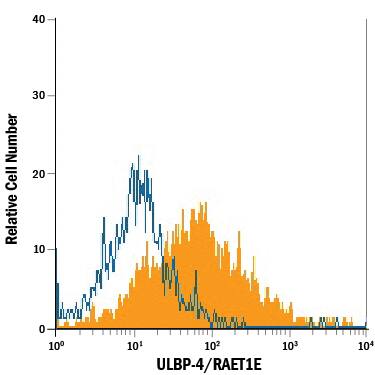Human ULBP-4/RAET1E Antibody
R&D Systems, part of Bio-Techne | Catalog # MAB6285


Conjugate
Catalog #
Key Product Details
Species Reactivity
Validated:
Human
Cited:
Human
Applications
Validated:
CyTOF-ready, Flow Cytometry, Immunohistochemistry, Western Blot
Cited:
Flow Cytometry, Immunocytochemistry, Immunohistochemistry-Paraffin
Label
Unconjugated
Antibody Source
Monoclonal Mouse IgG2B Clone # 709116
Product Specifications
Immunogen
Mouse myeloma cell line NS0-derived recombinant human ULBP‑4/RAET1E
Gly30-Asp225
Accession # Q8TD07
Gly30-Asp225
Accession # Q8TD07
Specificity
Detects human ULBP‑4/RAET1E in direct ELISAs and Western blots. In Western blots, approximately 20% cross‑reactivity with recombinant human (rh) ULBP-2 is observed and no cross-reactivity with rhULBP‑1 or rhULBP-3 is observed.
Clonality
Monoclonal
Host
Mouse
Isotype
IgG2B
Scientific Data Images for Human ULBP-4/RAET1E Antibody
Detection of Human ULBP‑4/RAET1E by Western Blot.
Western blot shows lysates of HT-29 human colon adenocarcinoma cell line. PVDF membrane was probed with 1 µg/mL of Mouse Anti-Human ULBP-4/ RAET1E Monoclonal Antibody (Catalog # MAB6285) followed by HRP-conjugated Anti-Mouse IgG Secondary Antibody (HAF007). A specific band was detected for ULBP-4/RAET1E at approximately 40 kDa (as indicated). This experiment was conducted under reducing conditions and using Immunoblot Buffer Group 1.Detection of ULBP-4/RAET1E in HepG2 Human Cell Line by Flow Cytometry.
HepG2 human hepatocellular carcinoma cell line was stained with Mouse Anti-Human ULBP-4/RAET1E Monoclonal Antibody (Catalog # MAB6285, filled histogram) or isotype control antibody (MAB0041, open histogram), followed by Allophycocyanin-conjugated Anti-Mouse IgG Secondary Antibody (F0101B).ULBP‑4/RAET1E in Human Ovarian Cancer Tissue.
ULBP-4/RAET1E was detected in immersion fixed paraffin-embedded sections of human ovarian cancer tissue using Mouse Anti-Human ULBP-4/ RAET1E Monoclonal Antibody (Catalog # MAB6285) at 15 µg/mL overnight at 4 °C. Tissue was stained using the Anti-Mouse HRP-DAB Cell & Tissue Staining Kit (brown; CTS002) and counter-stained with hematoxylin (blue). Specific staining was localized to plasma membranes of epithelial cells. View our protocol for Chromogenic IHC Staining of Paraffin-embedded Tissue Sections.Applications for Human ULBP-4/RAET1E Antibody
Application
Recommended Usage
CyTOF-ready
Ready to be labeled using established conjugation methods. No BSA or other carrier proteins that could interfere with conjugation.
Flow Cytometry
0.25 µg/106 cells
Sample: HepG2 human hepatocellular carcinoma cell line, U‑87 MG human glioblastoma/astrocytoma cell line, and HEK293 human embryonic kidney cell line
Sample: HepG2 human hepatocellular carcinoma cell line, U‑87 MG human glioblastoma/astrocytoma cell line, and HEK293 human embryonic kidney cell line
Immunohistochemistry
8-25 µg/mL
Sample: Immersion fixed paraffin-embedded sections of human ovarian cancer tissue
Sample: Immersion fixed paraffin-embedded sections of human ovarian cancer tissue
Western Blot
1 µg/mL
Sample: HT‑29 human colon adenocarcinoma cell line
Sample: HT‑29 human colon adenocarcinoma cell line
Formulation, Preparation, and Storage
Purification
Protein A or G purified from hybridoma culture supernatant
Reconstitution
Sterile PBS to a final concentration of 0.5 mg/mL. For liquid material, refer to CoA for concentration.
Formulation
Lyophilized from a 0.2 μm filtered solution in PBS with Trehalose. *Small pack size (SP) is supplied either lyophilized or as a 0.2 µm filtered solution in PBS.
Shipping
Lyophilized product is shipped at ambient temperature. Liquid small pack size (-SP) is shipped with polar packs. Upon receipt, store immediately at the temperature recommended below.
Stability & Storage
Use a manual defrost freezer and avoid repeated freeze-thaw cycles.
- 12 months from date of receipt, -20 to -70 °C as supplied.
- 1 month, 2 to 8 °C under sterile conditions after reconstitution.
- 6 months, -20 to -70 °C under sterile conditions after reconstitution.
Background: ULBP-4/RAET1E
References
- Radosavljevic, M. et al. (2002) Genomics 79:114.
- Kondo, M. et al. (2010) Immunogenetics 62:441.
- Conejo-Garcia, J.R. et al. (2003) Cancer Biol. Ther. 2:446.
- Chalupny, N.J. et al. (2003) Biochem. Biophys. Res. Commun. 305:129.
- Cao, W. et al. (2007) J. Biol. Chem. 282:18922.
- Kong, Y. et al. (2009) Blood 114:310.
- Bacon, L. et al. (2004) J. Immunol. 173:1078.
- Cao, W. et al. (2008) Int. Immunol. 20:981.
Long Name
UL16 Binding Protein-4
Alternate Names
LETAL, N2DL-4, N2DL4, NKG2DL4, RAET1E, RL-4, ULBP4
Gene Symbol
RAET1E
UniProt
Additional ULBP-4/RAET1E Products
Product Documents for Human ULBP-4/RAET1E Antibody
Product Specific Notices for Human ULBP-4/RAET1E Antibody
For research use only
